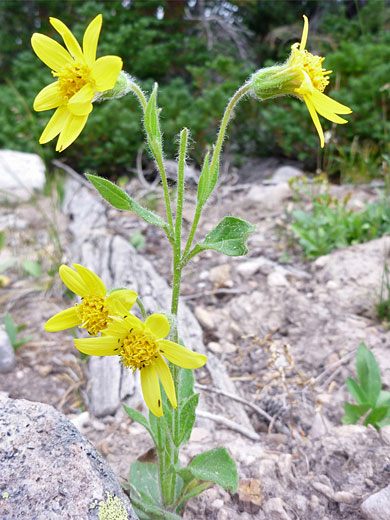Common names:
Sticky arnica, lawless arnica
Family:
Scientific name:
Arnica ovata
Synonym:
Arnica diversifolia
Main flower color:
Range:
The Pacific states, plus parts of Nevada, Utah, Idaho and Montana
Height:
Between 6 and 24 inches
Habitat:
Moist grassland, rocky slopes or coniferous forests in mountainous areas
Leaves:
Deltoid (triangular), with a few irregular teeth along the edges. Up to 3 inches long
Season:
June to August
Arnica ovata (previously arnica diversifolia) is a sparsely-leaved plant; stems usually have just two or three pairs, the largest about half way up. Those lower down have stalks; the uppermost pair is stalkless. Leaves, stems and involucres are all covered with short, sticky, glandular hairs.
Plants have a small number of flowerheads, usually one, two or three, each with between 8 and 13 wide, grooved ray florets and a center of small disc florets (fewer than in many similar species) that elongate as they mature. The flower head is supported by a ring of green, pointed involucral bracts. The plant is less common than some other arnicas, restricted to medium to high elevation areas in the mountains of the Pacific and northern Rocky Mountain states.
Plants have a small number of flowerheads, usually one, two or three, each with between 8 and 13 wide, grooved ray florets and a center of small disc florets (fewer than in many similar species) that elongate as they mature. The flower head is supported by a ring of green, pointed involucral bracts. The plant is less common than some other arnicas, restricted to medium to high elevation areas in the mountains of the Pacific and northern Rocky Mountain states.
All Contents © Copyright The American Southwest | Comments and Questions | Contribute | Site Map


